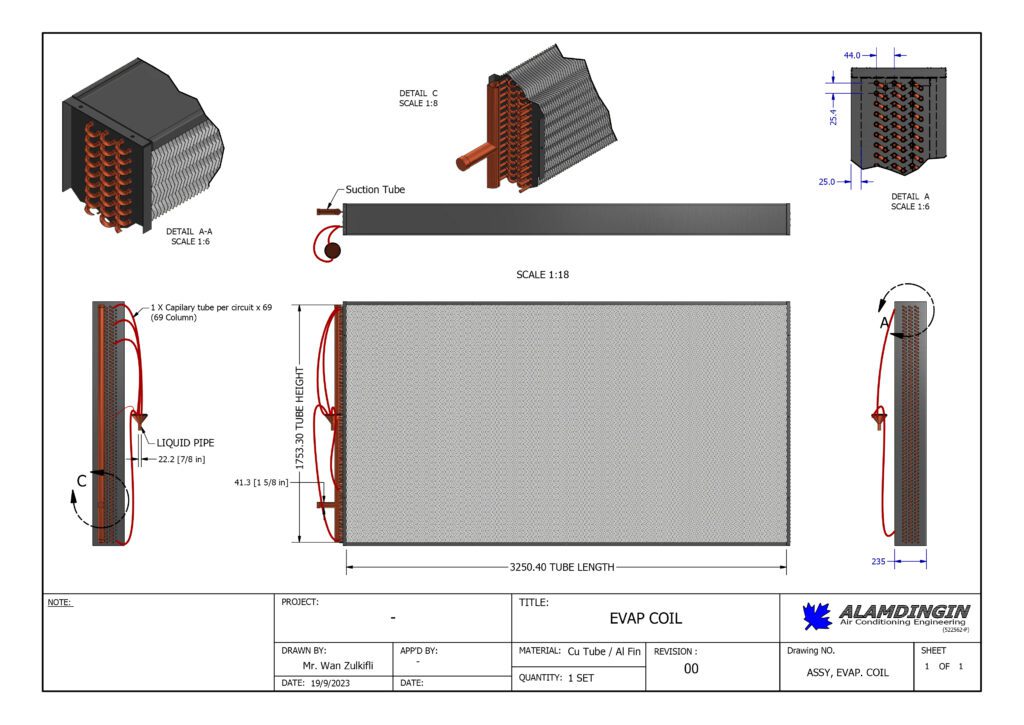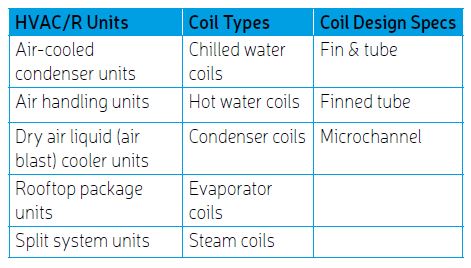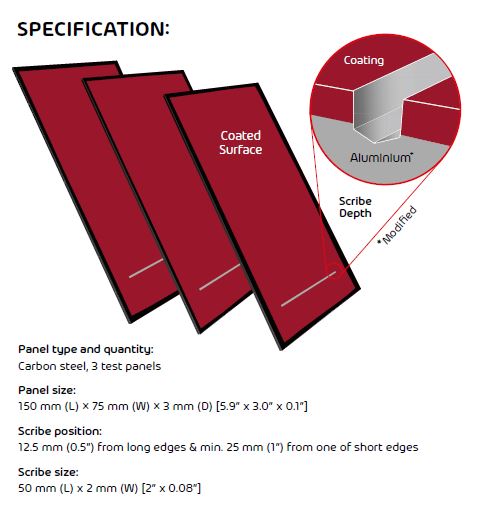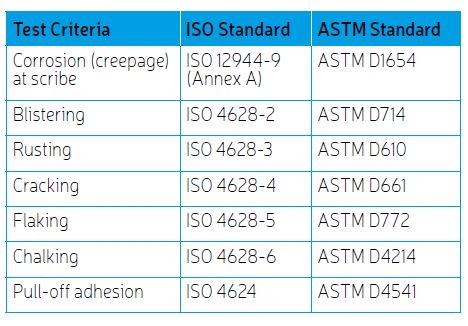The design of HVAC/R coatings is driven by the need to protect aluminium-finned, copper-tubed, galvanised iron-encased heat exchanger coils from corrosion, whose performance is tested and evaluated using a series of ASTM and ISO standards. How they relate to the real world, how they compare, and their relevance to HVAC/R end-use require careful analysis.
By Craig J R Thomas, HVAC/R Coating Specialist & Senior Managing Consultant – The Pipe-Sol Consultancy Ltd
What is a heat exchanger? There are many types. One definition might be – a system used to transfer heat from one medium to another in both heating and cooling processes. “Coil” units designed and manufactured using a series of aluminium fins and copper tubes (Figure 1) are a type of heat exchanger most prevalent in the air conditioning and refrigeration industry, and most frequently specified on the grounds of heat transfer capability and cost.
Heating, ventilation, air conditioning and refrigeration (HVAC/R) systems employ various technologies to control temperature, humidity and air purity. HVAC/R systems provide heating and/or cooling for residential, commercial, industrial and institutional buildings.

There are many types of HVAC/R unit (Table 1) and the vulnerable design element that links them all is the coil. It should be of primary importance to the operator of aluminium-finned, copper-tubed HVAC/R coils, which are normally housed in a galvanised iron (or steel) casing that such critical assets are protected to maximise efficiency and extend life expectancy.

Protected from the environment and protected from each other. The aluminium and copper will require protection from atmospheric corrosion and chemical attack. And consideration should be given to protect (isolate) each metal component from the adjoining metal component. If not, galvanic (bi-metallic) corrosion (Figure 2) may occur.
A high-performance HVAC/R coating is the solution. Standards have been developed and coating tests employed since the 1960s to measure the effectiveness of coatings designed to protect the various metals used in the manufacture of these HVAC/R coil units from corrosion. What is critical is that the standard represents the real-world environment as closely as possible and that it is relevant to the HVAC/R end-use.
As an industry, it is incumbent on its stakeholders to technically understand these standards, be aware of the sometimes subtle differences between them, how they can be modified or other tests added to make them more relevant to HVAC/R operations. These stakeholders may be design engineers/specifiers, applicators, coating manufacturers, original equipment manufacturers and HVAC/R unit operators. Regrettably, the gaps in knowledge and understanding of such standards can result in wrongly specified coatings, and ultimately (premature) failures.

(salt) water.
Standards from both the International Standards Organisation (ISO) and the American Society for Testing and Materials (ASTM) are used for high-performance coatings for HVAC/R coils. ISO is recognised globally. ASTM is very widely used and accepted in the United States, although it does appear in international specifications and testing requirements.
Their usage varies based on geographic location and “grandfather rights” related to specifications. Their dominance varies based on a contest to be real and relevant. How do they relate / correlate to the real world and how relevant are they to the HVAC/R industry or coil unit that they are used to protect?
A previous article has been written and published in Heat Exchanger World1 offering an overview of coating performance standards and their correlation to real-world environments, so this piece focuses on the actual standards, and drills down into the detail of the testing.
A number of correction protection standards exist, published by ASTM, ISO and other standards organisations, which include ASTM B117, ASTM G85, ASTM D5894, ISO 9227, and ISO 12944 as well as JIS Z 2371 and NORSOK M-501. And although not all will be discussed in this article, some may be mentioned for context and comparison. Focus has been given to ASTM B117 and ISO 12944-9, as these are the two test standards that are most actively used in the HVAC/R industry today.
ASTM B117
The very first version of ASTM B117 was published in 1964, the most recent being released in 2019. The scope of ASTM B117 “covers the apparatus, procedure, and conditions required to create and maintain the salt spray (fog) test environment” and “does not prescribe the type of test specimen or exposure periods to be used for a specific product, nor the interpretation to be given to the results.”2 Carbon-steel specimen panels measuring 5” × 3” × 0.3” (127 mm × 76 mm × 8 mm) or 6” × 4” × 0.3” (152 mm × 102 mm × 8 mm) are typically used depending on the cabinet specification.
These are suitably prepared and coated, and a single scribe is made to the panel at a minimum distance of 0.5” (12.7 mm) from any edge (ASTM D1654), penetrating the entire thickness of the coating to the metal substrate. The scribed panels are placed in a rack in a salt spray cabinet at an angle of 15-30° from the vertical orientation, and continuously exposed to the prescribed salt spray for the specified duration of the test. The salt spray is created by atomising a solution of 5% Sodium Chloride (NaCl) or Salt at 35°C ± 2°C (95°F ± 3°F), which is sprayed upwards allowing the salt (water) fog droplets to descend and settle on each test panel without contaminating any neighbouring specimens. The pH of the collected solution after atomisation at this temperature shall be 6.5 to 7.2. The Relative Humidity (RH) shall be 95-98%.
This test is modified for HVAC/R coatings, whereby aluminium panels are used, as this is one of the metals of choice used to produce the coil unit fins, which if left untreated can corrode, although copper and steel can also be used. It is also important to note that Filiform Corrosion (FFC) can occur under thin film organic coatings applied to aluminium substrates that have a dry film thickness of less than 100 microns (4 mils).³

A variable that is likely to impact test result consistency and more importantly coating performance is the method and quality of surface preparation, which ASTM B117 does not prescribe. Panel conditioning is another variable. Coating thickness and number of coats are further sets of variables affecting performance.
After exposure, the number of blisters (from scribe), degree of blistering (ASTM D714) and scribe creepage (ASTM D1654) are typically evaluated. Test durations of static salt spray tests used by the HVAC/R industry of 10,000 hours are not uncommon, with some exceeding this threshold and reaching 20,000 hours, although supporting test data are not always publicly available. 20,000 hours equates to over 2 years of continuous salt spray exposure. It should be, however, noted that atmospheric conditions do not remain unchanged indefinitely and levels and types of man-made contamination vary. Corrosion resistance is not chemical resistance and chemical resistance is not tested unless otherwise specified.
ASTM B117 is a continuous test; static and non-cyclic (Figure 3). Although reliance on the standard has declined, it is still commonly used in the HVAC/R coatings industry forming part of many specifications and manufacturer testing protocols to demonstrate performance, even though ASTM advises “Prediction of performance in natural environments has seldom been correlated with salt spray results when used as stand alone data.”2 ASTM B117 test protocols were modified in 2001, creating ASTM D4587 ((cyclic) salt spray combined with UV/condensation exposure).
ISO 12944-9 and its component parts
ISO 12944 was first introduced in 1998 as an eight-part standard and was revised for a second time in 2018, which included the addition of Part 9, which itself replaced ISO 20340. ISO 12944-9 specifies the performance requirements for protective coating systems for offshore structures, establishing a new ‘CX’ corrosivity category. The duration of the exposure cycle is one week (168 h), and the standard specifies 25 full cycles (4,200 hours) – Figure 5.
ISO 12944-9 comprises three main tests, two of which can individually be used, and each governed by its own standard:
- UV/condensation – ISO 16474-3
- Neutral salt spray – ISO 9227
- Low (sub-zero) temperature exposure

ISO 16474-3
ISO 16474-3 specifies the methods for exposure of coatings to daylight (UV-A), heat and water, which are designed to better reproduce the weathering effects that occur when coated metal substrates are exposed to real-world environments.
Daylight is simulated by using UVA-340 fluorescent lamps. The panels shall be exposed for 4 hours at 60°C ± 3°C (140°F ± 5°C) alternating with 4 hours of (dark) condensation exposure at 50°C ± 3°C (122°F ± 5°C). The standard specifies black-panel temperatures. The alternative ASTM standard is G154.
ISO 9227
ISO 9227 is almost identical to ASTM B117 and was first introduced in 1990. It is also a continuous, static salt spray test. ISO 9227 specifies “the apparatus, the reagents and the procedure to be used in conducting the neutral salt spray (NSS) (…) tests for assessment of the corrosion resistance…”⁴. “It does not specify the dimensions or types of test specimens, the exposure period to be used for a particular product, or the interpretation of results.”⁴
In addition to NSS, ISO 9227 also describes how to carry out more aggressive testing using acetic acid salt spray (AASS) and copper-accelerated acetic acid salt spray (CASS).
The test method calls for a neutral 5% Sodium Chloride (salt) solution to be atomised in a controlled environment and at a constant temperature of 35°C ± 2°C (95°F ± 4°F). RH is not specified. The pH of the salt solution collected shall be 6.5 to 7.2 at 25°C ± 2°C (77°F ± 4°F) and adjusted accordingly. The test panels shall be placed in the test cabinet, so they are not directly exposed to the salt spray from the atomiser, they do not come into contact with or are affected by the cabinet (surfaces), and the fog droplets that form and fall naturally on the panels do not drip onto other test specimens below. The angle of exposure of the coated panel is very important and shall be as close as possible to 20° to the vertical, and in all cases between 15-25°.
When an organic coating is to be tested, the standard calls for the coating to be dried (cured), conditioned, and scribed (ISO 17872). The scribe can be X-shaped, T-shaped or a single line. For salt spray tests, a horizontal line is generally preferred, as more salt is collected in a horizontally exposed scribe mark, which will also generate a more even salt distribution. For coated aluminium panels, two scribe marks shall be made, which are perpendicular to, but do not intersect each other in accordance with ISO 4623-2 (Determination of resistance to filiform corrosion). Aluminium is used to manufacture a coil finned pack. The period of exposure to NSS is not specified, although recommended test intervals are given.
ISO 12944-9 test panels and performance variables
ISO 12944-9 re-specifies the type, size and quantity of test panels required for each test as well as the type and size of scribe (Figure 4). Each test panel shall be scribed to ensure the coated metal surface is exposed to all the elements of the test. Some coating manufacturers prefer to also make an additional scribe along the length and in the centre of the panel, a minimum 12.5 mm (0.5”) from the edges to match the scribe detailed in ASTM B117.

ISO 12944-9 states that the durability of a coating system depends on many factors such as the environment, surface preparation, the application and drying (curing) / conditioning procedures. Durability is also determined by the chemical and physical characteristics of the coating, e.g. the type of binder and the DFT. The influence of these characteristics on the durability is evaluated by artificial-ageing tests under this standard. Coating resistance to moisture (condensation) and salt (water) fog, as an indication of wet adhesion and barrier properties are of primary interest. Additional variables exist in the form of the number of coats as well as the type and method of conditioning. ISO 12944-9 lays down some guidance under #9.1.6, referencing ISO 3270.
As regards the assessment of coated test panels, ISO 12944-9 requires that two out of the three panels comply with the requirements detailed in Table 2. ASTM alternatives, which are sometimes used, are given for reference. Notwithstanding the cyclic nature of the testing,
ISO 12944-9 still states the “results from artificial-ageing tests shall be used with caution. It shall be clearly understood that artificial ageing will not necessarily have the same effect as natural exposure.”⁴
HVAC/R coil coatings & testing relevance
This article will not critique HVAC/R coatings available in the market, and what is more important is to understand the different coating solutions that can be accessed – from baked phenolic epoxy to air-dry, water-based acrylic coatings – depending on the project/specification/client requirements of corrosion protection performance, specific properties such as chemical resistance, % effect on heat transfer, need to protect the whole heat exchanger/coil unit, availability of application know-how and equipment (spray, dipping, flow coating, curing oven etc.), and need for low/zero VOC technology. Other binders can be used. Organic and inorganic chemistry can be employed. Coating properties can also be changed for a specific project through the use of additives – e.g. bacterial resistance.

The right tests/standards need to be selected, the test protocols fully understood, and their relevance to the HVAC/R end-use be discerned. It is quite acceptable to modify tests to make them relevant, such as use of aluminium/copper panels for testing, addition of chemical resistance testing, use of single- or multi-layer coating systems (incorporating primers or conversion coatings), as long as the test report clearly defines these modifications and the (end-)user is educated on the reasons.
To this end, and to cite several examples, chemical spot testing can be carried out using a number of different standards – ISO 2812-4, ASTM D1308, ASTM D4752 / ASTM D5402. It is possible to test HVAC/R coatings in conditions to simulate more aggressive (acidic) environments using a salt water acetic acid test (SWAAT test) – ASTM G85 (A3) or acetic acid salt spray (AASS) test – ASTM 9227 (#5.2.3).
It is also possible to test against ISO 12944-6 to grade the performance of HVAC/R coatings and determine their relevance to the corrosion protection requirements of the project by using the (C3-C5) corrosivity categories laid down in ISO 12944-2.
Conclusion
Both ASTM and ISO corrosion protection standards continue to be used in the HVAC/R industry today. ASTM B117 is a static, continuous, non-cyclic test, and for these reasons it can be questioned whether such test conditions correlate with a real-world environment. ISO 12944-9 is cyclic with varying exposure to UV (sunlight), condensation (moisture) and salt (water) spray as well as freeze-thaw weathering, so represents an improvement over ASTM B117, as it better replicates actual atmospheric conditions.
Both ASTM B117 and ISO 12944-9 still need to be modified to make them relevant to HVAC/R end-use, and the service environment, in which they operate. This relevance shall cover the metals to be tested, evaluation of chemical resistance and ability to perform in more acidic/aggressive conditions, and use of surface preparation techniques and coating thickness/layers to allow the coating to perform. What is critical is that specific standards are named, and modifications thereto are documented so that informed decisions by project stakeholders can be made.
In 2023, ISO 12944-9 still exists as the corrosion protection standard against which all HVAC/R coatings for heat exchanger coils should be tested, whose correlation to actual (service) conditions can be strengthened through the implementation of additional testing.
About the author
 Craig set up his own international consultancy business in 2016, focusing most recently on HVAC/R coatings. He has over 20 years’ experience in the field of protective coatings, and has worked with/for 3M, Copon- E Wood, Jotun, Kansai Paint, and Heresite. He is a certified NACE coating inspector (level 1) and an ASHRAE Associate Member. Craig is also a Brand Ambassador for Jettyrobot – supplier of unique and patented robotic HVAC duct and pipe cleaning technology.
Craig set up his own international consultancy business in 2016, focusing most recently on HVAC/R coatings. He has over 20 years’ experience in the field of protective coatings, and has worked with/for 3M, Copon- E Wood, Jotun, Kansai Paint, and Heresite. He is a certified NACE coating inspector (level 1) and an ASHRAE Associate Member. Craig is also a Brand Ambassador for Jettyrobot – supplier of unique and patented robotic HVAC duct and pipe cleaning technology.
References
1. THOMAS, C.J.R., “HVAC/R coatings: standards, development & performance”, Heat Exchanger World, may 2022.
2. American society for testing and materials [ASTM] (2019), astm b117-19 standard Practice for Operating salt spray (Fog) apparatus, ASTM (Online), available at https://www.astm.org
3. THOMAS, C.J.R, “Filiform corrosion – an unidentified enemy to aluminium fins”, Heat Exchanger World, April 2023.
4. International standards Organisation [ISO] (2018), ISO 12944-9:2018 Paints and varnishes — corrosion protection of steel structures by protective paint systems – Part 9: Protective paint systems and laboratory performance test methods for offshore and related structures), isO (Online), available at https://www.iso.org
References to Standards
- ASTM B117-19 – Standard Practice for Operating Salt Spray (Fog) Apparatus
- ASTM D1308-20 – Standard Test Method for Effect of Household Chemicals on Clear and Pigmented Coating Systems
- ASTM D1654-08(2016) – Standard Test Method for Evaluation of Painted or Coated Specimens Subjected to Corrosive Environments
- ASTM D4214-07(2015) – Standard Test Methods for Evaluating the Degree of Chalking of Exterior Paint Films
- ASTM D4541-22 – Standard Test Method for Pull-Off Strength of Coatings Using Portable Adhesion Testers
- ASTM D4587-23 – Standard Practice for Fluorescent UV-Condensation Exposures of Paint and Related Coatings
- ASTM D4752-20 – Standard Practice for Measuring MEK Resistance of Ethyl Silicate (Inorganic) Zinc-Rich Primers by Solvent Rub
- ASTM D5402-19 – Standard Practice for Assessing the Solvent Resistance of Organic Coatings Using Solvent Rubs
- ASTM D5894-21 – Standard Practice for Cyclic Salt Fog/UV Exposure of Painted Metal, (Alternating Exposures in a Fog/Dry Cabinet and a UV/Condensation Cabinet)
- ASTM D610-08(2019) – Standard Practice for Evaluating Degree of Rusting on Painted Steel Surfaces
- ASTM D661-93(2019) – Standard Test Method for Evaluating Degree of Cracking of Exterior Paints
- ASTM D714-02(2009) – Standard Test Method for Evaluating Degree of Blistering of Paints
- ASTM D772-18 – Standard Test Method for Evaluating Degree of Flaking (Scaling) of Exterior Paints
- ASTM G154-23 – Standard Practice for Operating Fluorescent Ultraviolet (UV) Lamp Apparatus for Exposure of Materials
- ASTM G85-19 – Standard Practice for Modified Salt Spray (Fog) Testing
- ISO 12944-2:2017 – Paints and varnishes — Corrosion protection of steel structures by protective paint systems. Part 2: Classification of environments
- ISO 12944-6:2018 – Paints and varnishes – Corrosion protection of steel structures by protective paint systems. Part 6: Laboratory performance test methods
- ISO 12944-9:2018 – Paints and varnishes — Corrosion protection of steel structures by protective paint systems. Part 9: Protective paint systems and laboratory performance test methods for offshore and related structures
- ISO 16474-3:2021 – Paints and varnishes — Methods of exposure to laboratory light sources. Part 3: Fluorescent UV lamps
- ISO 17872:2019 – Paints and varnishes – Guidelines for the introduction of scribe marks through coatings on metallic panels for corrosion testing
- ISO 20340:2009 – Paints and varnishes – Performance requirements for protective paint systems for offshore and related structures
- ISO 2812-4:2017 – Paints and varnishes – Determination of resistance to liquids – Part 4: Spotting methods
- ISO 3270:1984 – Paints and varnishes and their raw materials – Temperatures and humidities for conditioning and testing
- ISO 4623-2:2016 – Paints and varnishes – Determination of resistance to filiform corrosion. Part 2: Aluminium substrates
- ISO 4624:2023 – Paints and varnishes – Pull-off test for adhesion
- ISO 4628-2:2016 – Paints and varnishes – Evaluation of degradation of coatings – Designation of quantity and size of defects, and of intensity of uniform changes in appearance. Part 2: Assessment of degree of blistering
- ISO 4628-3:2016 – Paints and varnishes – Evaluation of degradation of coatings – Designation of quantity and size of defects, and of intensity of uniform changes in appearance. Part 3: Assessment of degree of rusting
- ISO 4628-4: 2016 – Paints and varnishes – Evaluation of degradation of coatings – Designation of quantity and size of defects, and of intensity of uniform changes in appearance. Part 4: Assessment of degree of cracking
- ISO 4628-5:2022 – Paints and varnishes – Evaluation of quantity and size of defects, and of intensity of uniform changes in appearance. Part 5: Assessment of degree of flaking
- ISO 4628-6:2011 – Paints and varnishes – Evaluation of degradation of coatings – Designation of quantity and size of defects, and of intensity of uniform changes in appearance. Part 6: Assessment of degree of chalking by tape method
- ISO 6270-1:2017 – Paints and varnishes – Determination of resistance to humidity – Part 1: Condensation (single-sided exposure)
- ISO 9227:2022 – Corrosion tests in artificial atmospheres – Salt spray tests
- JIS Z 2371:2015 – Methods of salt spray testing
- NORSOK M-501:2022 – Surface preparation and protective coating
About this Featured Story
This Featured Story was first published in Heat Exchanger World Magazine in October 2023. To read more Featured Stories and many other articles, subscribe to our print magazine.
Featured Stories are regularly shared with our Heat Exchanger World community. Join us and share your own Featured Story on Heat Exchanger World online and in print.


